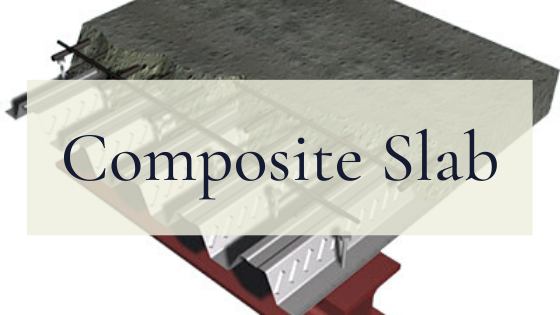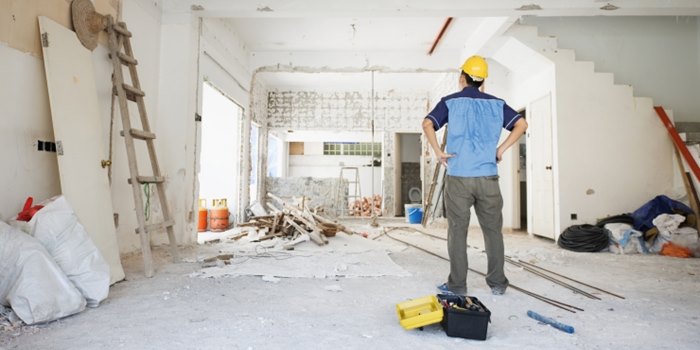
The composite slab is one of the essential floor systems used in the construction of steel structures.
Composite slabs comprise ferroconcrete sew the very best of profiled steel decking, which acts as formwork during construction and external reinforcement at the last word stage. The decking may be either re-entrant or trapezoidal.
In other words, A composite slab is a slab made with profiled steel sheeting as permanent shuttering, capable of sustaining the weight of the wet concrete, the reinforcement steel, and the construction imposed loads in the construction phase.
Types of Composite Beam
Downstand beams
One of the most common forms where a composite slab sits on top of a downstand beam, connected by the use of through deck welded shear studs. This form of construction offers several advantages – the decking acts as external reinforcement at the composite stage, and during the construction stage as formwork and a working platform.
Long Span
A variation of downstand beams to meet long-span needs. They provide the opportunity to achieve longer spans (20 m or more) than are possible using a standard robust web, rolled downstand beam.
Shallow floor
Shallow floors offer a range of benefits, such as minimizing the overall height of a building for a given number of floors or maximizing the number of floors for a given height of the building. Additionally, a flat soffit is achieved, which gives complete freedom for the distribution of services below the floor.
Load Calculation on Composite Slabs
It is considered crucial to define and assess construction loads on the composite slab to prevent slab failure during construction.
If such failure occurs, not only will the lives of labourers and workers be lost, but it also would be considerably costly.
Therefore, the description and computation of construction loads are invaluable.
Types of Construction Loads
Types of construction loads imposed on composite slabs are categorized into two major groups:
- Construction loads imposed during concreting
- Construction loads exerted after concreting.
Construction Loads Imposed During Concreting
The construction loads on the composite slab during concreting comprises the weight of the worker, fresh concrete, pipelines, formworks and load-bearing elements, the weight of small equipment, and impact forces.
The construction loads that structural designers should account for include the weight of concreting staff, and their number should not be higher than six men, and only four of them should be around the pipeline’s outlet.
Concerning a load of formworks and small equipment, they can be computed and accounted for quickly during the design.
As far as the concrete load is concerned, it is specified that the height of concrete should not be higher than the knee level above decking, and the designer considers the amount of concrete that is poured accordingly. This will ensure that an excessive impact load is not imposed.
The weight of the pipeline considered by the structural designers is the weight of a 150mm pipe full of concrete. This load needs to be appropriately distributed over larger areas using suitable means such as timber. This measure is recommended to prevent local damages of decking.
Another load encountered during concreting considered by the designer is a cone of heaped concrete with a height of 20cm and with the base of 100cm. It is suggested that the outlet of the pipeline is moved regularly to prevent too much heaping. It is necessary to control the discharge of the concrete when a skip is employed for concreting.
It is likely to place extra concrete if decks and steel beams deflect, especially when the slab is required to be finished at a specified level. The placement of extra concrete needs to be conducted with the consultation of the structural designer to check whether such an additional load is permitted according to the design or not.
Construction Loads Exerted After Concreting
Loads that may be imposed on the composite slab include bags of fire protection, skips of debris, pallets of blocks, and other equipment.
If these loads are no more 1.5KN/m2, then it is considered that extra loads are not imposed on concrete, and hence it would not impair undesired effect on a recently placed concrete slab.
However, if such loads are larger than 1.5KN/m2, then the strength of the concrete need to be considered and such loads must not be imposed till the concrete achieve about 75 percent of its strength.
If the composite slab is loaded before the age of 28 days, then the concrete’s strength should be estimated through testing concrete, whether it is cylinder or cube samples.
In the design, objects that comprise construction loads after concreting are placed on pallets that are positioned on supporting beams.
When heavy construction loads are present, then the structural designer should be consulted, and such loads should be positioned on beams.
Also Read:

